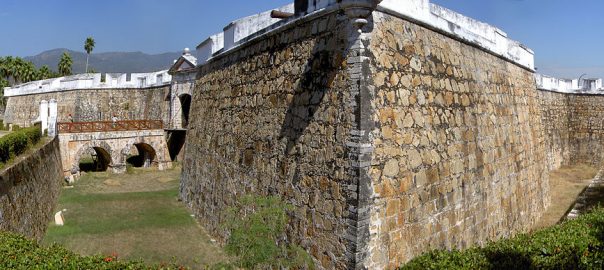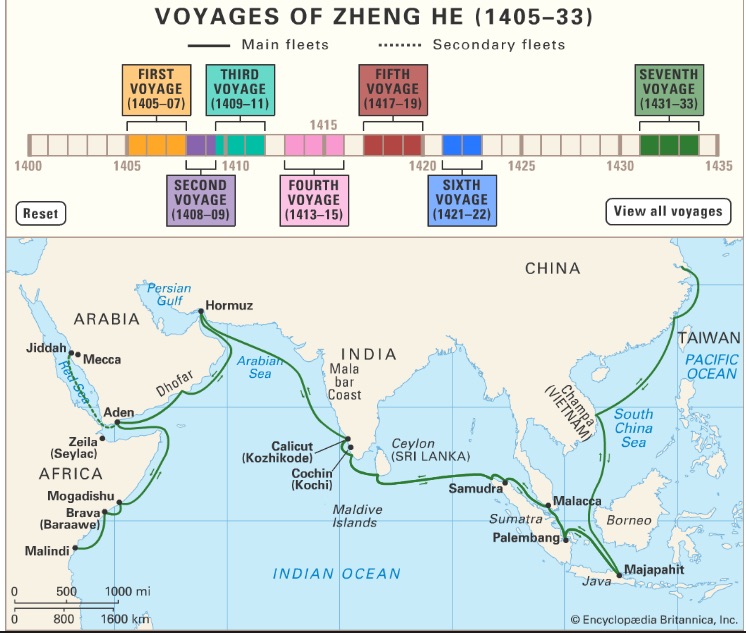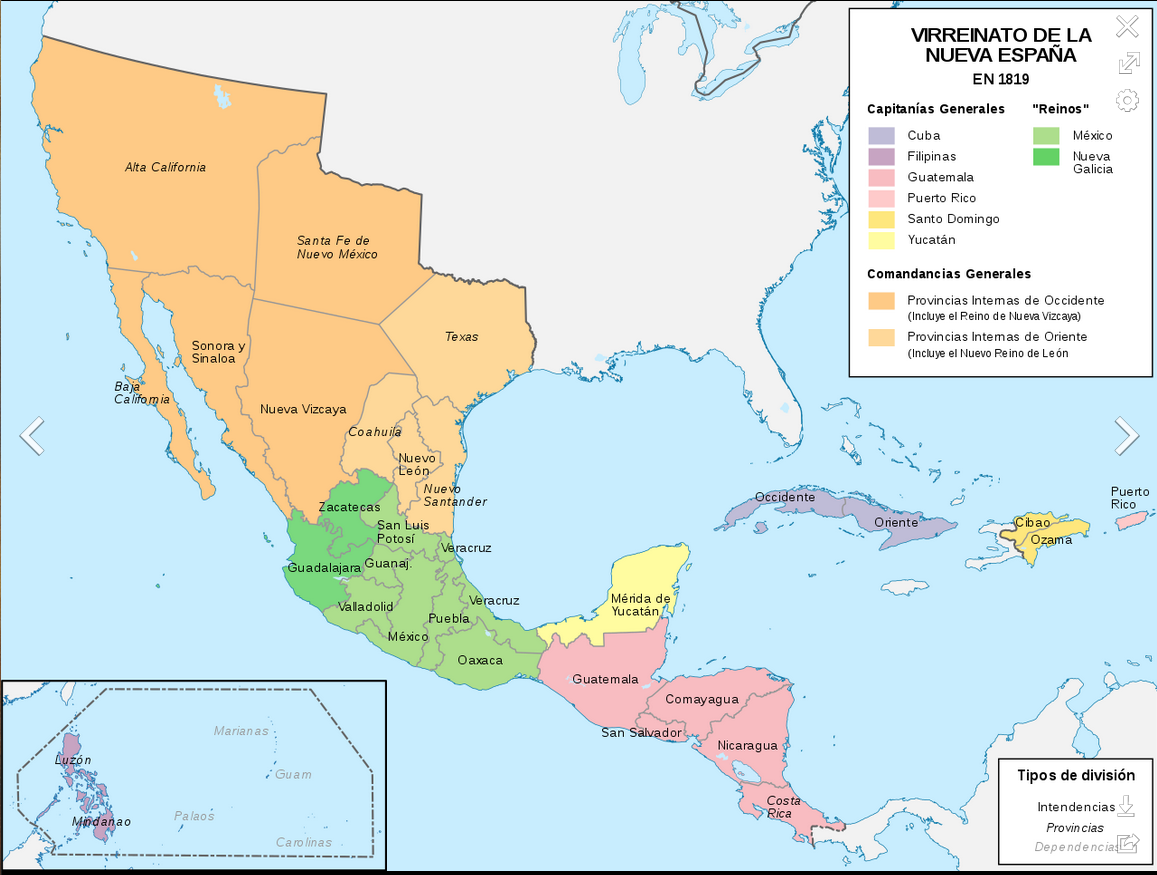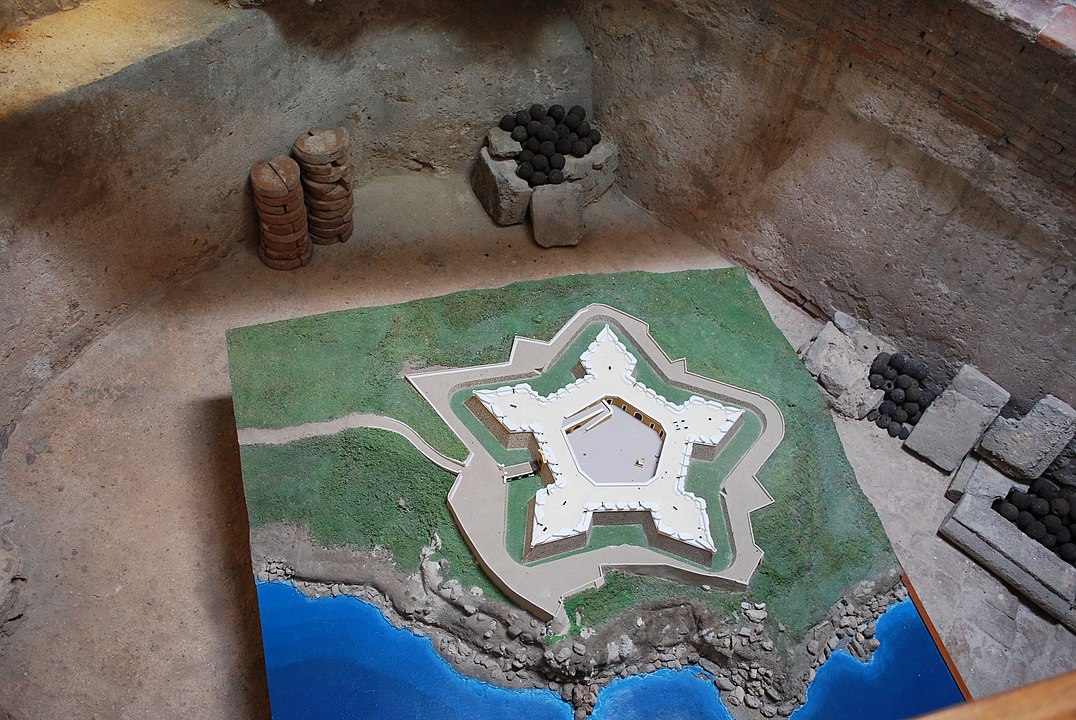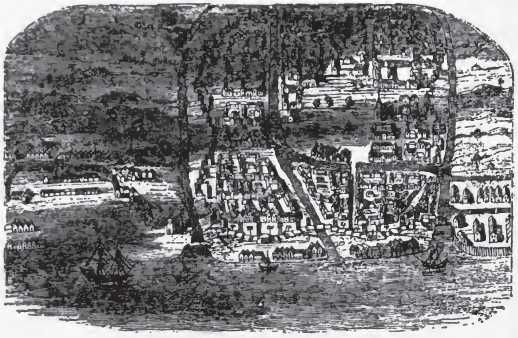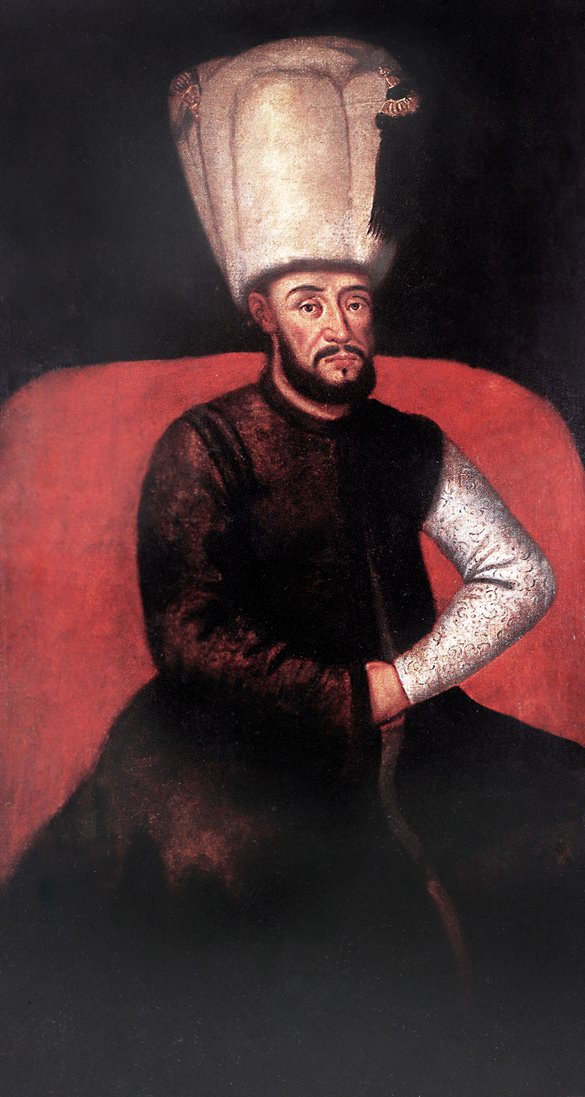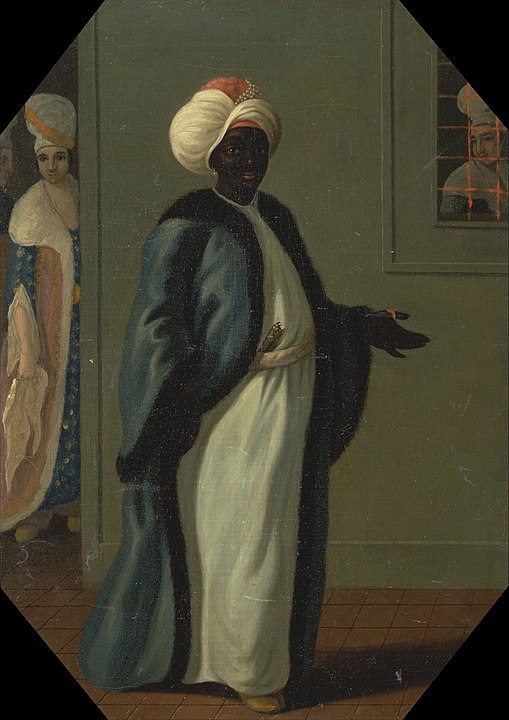In 1617 CE, national/imperial power is already clearly emerging as a function of command of global sea-lanes. Now and over the centuries ahead, land-based empires that don’t have a robust and feisty presence in the world’s great oceans will all be falling under the heel of the sea-based European powers. That has already happened to the great land-based empires of the Americas, and we will see it happening to the Mughals, the Ming and those who will follow them in China, the Ottomans, and others of the great land-based empires. To some extent, my chronicling of their fortunes already feels doom-laden.
I’ve thought quite a bit about how to characterize the Ottomans. Were they “Europeans”, or not? (In good part, yes?) Were they land-based, or not? Originally, yes, but for a long time they had strong naval presences in both the Mediterranean and the Black Sea, and once they’d taken over Mamluk Egypt and Iraq they had access to both the Red Sea and the Persian Gulf. In 1615-17, their Mediterranean navy did make attempts to exit the Straits of Gibraltar and attack Cadiz, and to capture Malta. But both those attempts failed. If I were the Grand Vizier(-ess) of the empire, I would have planned to use the empire’s port on the Red Sea, Suez, as a base to make a big push into the Indian Ocean, its busy sea-lanes, and the world beyond. But they never did that, early ceding much control in the Red Sea to the Portuguese. And it’s true, their military planners faced a lot of land-based challenges, all around the empire, to which they had to respond.
I believe it was a similar concern that in 1433 had led the Ming emperor to end the wide Indian Ocean voyaging of Admiral Zheng He: his empire needed to focus on some big land-based threats at home.
Meantime– at that exact same time– the Portuguese navy was starting its creep down the west coast of Africa that would inaugurate the massive explosion of West European navies into all the world’s oceans that would come in its train. And all the first four European powers that joined in that empire-building (a) were based on Atlantic/North Sea coast, and (b) had highly developed fighting navies whose skills had been honed for decades from fighting each other in their own coastal waters. Moreover, of those four (Portugal, Spain, Netherlands, and England), only Spain controlled a sizeable land-mass and needed also to maintain sizeable land armies to protect it.
Actually, I don’t think Spain needed to maintain a sizeable land army. The Pyrenees gave them great protection from marauders to the northeast! But King Charles and King Philip II both wanted to control as much of Europe as they could, in their capacity as “Holy Roman Emperor”; and that necessitated big, expensive land armies. Actually, the need to pay for those armies helped push the Spanish kings to maximize the plunder they could grab from the silver and gold mines of South America; and the skills their key land-fighting formations, the tercios, continued to develop in Europe throughout the 16th century were almost certainly a big factor that helped them not only to seize but also to maintain control of massive tracts of land in the Americas, and to organize it for the continued expansion of their colonial presence there. By contrast, until 1617 the Portuguese, Dutch, and English attempts at empire building all showed far less aptitude for control of land-masses and much greater reliance on naval and coastal operations.
… Just a few observations there. Now, on to the main business of the year. Spain, then England, then the intrigues in the Topkapi Palace.
Spanish empire consolidates in Americas, expands in Philippines
Yes it is true that in the interior of today’s Mexico the Tepehuán people continued the heroic resistance I described yesterday; that in south-central Chile the Mapuche continued to resist; and doubtless that in many other places in Spain’s massive empire the indigenes were resisting courageously and often for periods of decades. But the steady drumbeat of imperial growth and consolidation continued, little dented.
In 1617, the Viceroyalty of New Spain created a new sub-division, the Captaincy General of Yucatán, which was intended to provide more autonomy for the Yucatán Peninsula, previously ruled directly by a simple governor. English-WP tells us:
Its creation was part of the, ultimately futile, Habsburg attempt in the late 16th century to prevent incursion into the Caribbean by foreign powers, which also involved the establishment of Captaincies General in Puerto Rico, Cuba, and neighboring Guatemala… The province and captaincy general covered the territory that today are the States of Campeche, Quintana Roo, Tabasco, Yucatán, and nominally the northern areas of Petén and Belize.

Further south, the Viceroyalty of Peru was also refining its colonial-administration apparatus. It created the Governorate of Paraguay, originally called the Governorate of Guayrá. Its seat was the city of Asunción; its territory roughly encompassed the modern day country of Paraguay. It was created by royal decree in December 1617, by splitting the previous Governorate of the Río de la Plata and of Paraguay into its respective halves.
And beyond finetuning its administration of colonial repression, the empire continued building new settler outposts in 1617. The following are recorded:
- The settler/missionary outpost of Bácum was founded in the south of today’s Mexican state of Sonora. It is one of eight mission villages founded in the early seventeenth century by colonial Spanish Jesuit missionaries for the Indian Reductions of the Yaqui people. WP tells us that, “The Yaqui developed their own syncretic form of the religion.” The “Reductions“, by the way, were a sort of church-run “strategic hamlet”– that is, a way of concentrating the indigenes into Spanish/church-controlled semi-urban spaces and to separate them from their traditional lands. They were used both in Spanish America and in the Philippine.
- The Jesuits also founded the settler-controlled town of Cócorit in the southern part of today’s Sonora. WP says that: “The name of the town is derived from the Yaqui (Yoem noki, or Hiak noki) word for a chili pepper, ko’oko’i” Also this: “The town was founded in 1617 by Spanish Jesuit missionaries… although the Spanish inhabitants were eventually forced to leave by the Yaqui native population of the area.”
- New Spain also built a big star fort, called the Fort of San Diego, in Acapulco. WP says it was built: “to protect Acapulco from attacks by pirates, since the city was an important trading port, being the point of departure for the Manila galleons. The fort was… completed in 1617 to designs of the Dutch military engineer Adrián Boot.” (By the way, the banner image above is a recent view of one corner of the fort.)
- And in Pila, in the Philippines, 1617 saw completion of the construction of a stone church, which “became the first church dedicated to St. Anthony in the country.” In 1581, Pila had been promoted from being a “Reduction” to being a parish.
England’s still-modest projects in E. Indies, Newfoundland
In 1617, the English EIC established a “Presidency” at the Company factory at Bantam in Java. It exercised its authority over all the Company factories in India, including the agencies of Madras, Masulipatnam and Surat.
Back in December 1602, the earliest EIC fleet had reached Bantam and its commander, James Lancaster, negotiated with the Sultan of Bantam over pepper purchases and the opening of a settlement. A “factory” (warehouse) was eventually opened with eight factors. The Bantam factory was therefore around a decade older than any of the EIC’s Indian outposts.
Neither Bantam’s supremacy over Surat nor indeed the existence of the factory-cum-presidency there would survive for very long.
And, on the other side of the world…
In 1617, a Welsh weirdo called William Vaughan (also described as “a poet and colonizer”) decided to found a colonial settlement in today’s Newfoundland in today’s Canada that he named Cambriol or New Cambriol. It was intended to be a little “New Wales” in the “New World”. He had purchased land for his colony from an outfit called the “Company of Adventurers to Newfoundland” that had gotten “monopoly” rights to Newfoundland from King James. (Who got them from… nobody.)
WP tells us that, “Vaughan had sent a number of settlers in 1617 with every good intention of making the maiden voyage himself and settling in his new colony with them. Because of ill health, Vaughan was not able to do so.” He eventually did get to go there, in 1622, and:
during his three or four years stay wrote [a book called] The Golden Fleece in an effort to stimulate the colonists into hard work. He returned to Britain to arrange publication of his work and returned to New Cambriol in 1628. The colony suffered terribly over the next few years due to harsh weather conditions and the constant destruction of property at the hands of the French and other Grand Bank fishermen.
Vaughan had returned to his native Wales in 1630 to settle his financial affairs and at the same time to convince his brother-in-law… and other “gentlemen of Wales” to join him in his colony at New Cambriol. Vaughan had offered grants of land but no one took him up on the offer.
FYI, Wales itself had been annexed by England in 1485. WP: “The last remnants of Celtic-tradition Welsh law were abolished and replaced by English law by the Laws in Wales Acts 1535 and 1542 during the reign of… Henry VIII. In the legal jurisdiction of England and Wales, Wales became unified with the kingdom of England.” (I had to look this up.)
The real eunuchs of Topkapi Palace
So in November 1617, the Ottoman empire’s Sultan Ahmed I died, still only 27 years old and at the end of a notably undistinguished 14-year reign. He was the first sultan for a long time who had not killed his brothers upon acceding to the throne. Perhaps Ahmed did not do this because, upon coming to the throne he was too young to have any sons or to have demonstrated his ability to do so? Perhaps he actually liked his only slightly younger full brother Mustafa? Anyway, when Ahmed died in 1617, possibly of typhus, 26-year-old Mustafa was the next sultan.
Actually, matters were not quite that straightforward. As his WP page tells us,
Ahmed’s death created a dilemma never before experienced by the Ottoman Empire. Multiple princes were now eligible for the Sultanate, and all of them lived in Topkapı Palace. A court faction headed by the Şeyhülislam Esad Efendi and Sofu Mehmed Pasha (who represented the Grand Vizier when he was away from Constantinople) decided to enthrone Mustafa instead of Ahmed’s son Osman. Sofu Mehmed argued that Osman was too young to be enthroned without causing adverse comment among the populace. The Chief Black Eunuch Mustafa Agha objected, citing Mustafa’s mental problems, but he was overruled.
Mustafa’s rise created a new succession principle of seniority that would last until the end of the Empire. It was the first time an Ottoman Sultan was succeeded by his brother instead of his son. His mother Halime Sultan became the Valide Sultan as well as a regent and wielded great power. Due to Mustafa’s mental conditions, she acted as a regent and exercised power more directly.
It was hoped that regular social contact would improve Mustafa’s mental health, but his behavior remained eccentric. He pulled off the turbans of his viziers and yanked their beards. Others observed him throwing coins to birds and fish. The Ottoman historian İbrahim Peçevi wrote “this situation was seen by all men of state and the people, and they understood that he was psychologically disturbed.”
Mustafa was never more than a tool of court cliques at the Topkapı Palace. In 1618, after a short rule, another palace faction deposed him in favour of his young nephew Osman II (1618–1622), and Mustafa was sent back to the Old Palace. The conflict between the Janissaries and Osman II presented him with a second chance. After a Janissary rebellion led to the deposition and assassination of Osman II in 1622, Mustafa was restored to the throne and held it for another year.
The page also cites some sources questioning whether the guy was actually unbalanced…
I might as well take this story a bit further forward? Mustafa commenced his second reign in 1622 thus:
by executing all those who had taken any share in the murder of Sultan Osman. Hoca Ömer Efendi, the chief of the rebels, the kızlar Agha [that is, the Chief Black Eunuch] Suleiman Agha, the vizier Dilaver Pasha, the Kaim-makam Ahmed Pasha, the defterdar Baki Pasha, the segban-bashi Nasuh Agha, and the general of the janissaries Ali Agha, were cut into pieces…
His mental condition unimproved, Mustafa was a puppet controlled by his mother and brother-in-law, the grand vizier Kara Davud Pasha. He believed that Osman II was still alive and was seen searching for him throughout the palace, knocking on doors and crying out to his nephew to relieve him from the burden of sovereignty.
Oh my God, all we need is another “False Dimitri” to show up here…
Anyway, it’s no surprise that infighting continued during his second reign. So, at one point in September 1623 this happened:
Clerics and the new Grand Vizier (Kemankeş Kara Ali Pasha) prevailed upon Mustafa’s mother to allow the deposition of her son. She agreed, on condition that Mustafa’s life would be spared. The 11-year-old Murad IV, son of Ahmed I and his wife Kösem Sultan, was enthroned on 10 September 1623… Mustafa was sent along with his mother to the Eski (old) Palace.
One source states that Mustafa was executed by the orders of his nephew, Sultan Murad IV on 20 January 1640… Another source states that he died of epilepsy which was caused by being imprisoned for 34 years out of his 48 years of life. He is buried in the courtyard of the Haghia Sophia.
As I hinted above, I am going to try not to spend too much time looking at the details of court life in these large, land-based empires. But I thought the reference to the “chief Black Eunuch” above was too intriguing to pass by. You can learn more about this position at this page on English-WP, which has this summary:
The kizlar agha (Ottoman Turkish: قيزلر اغاسی, Turkish: kızlar ağası, lit. '”agha of the girls”‘), formally the agha of the House of Felicity (Ottoman Turkish: دار السعاده اغاسي, Turkish: Darüssaade Ağası), was the head of the eunuchs who guarded the imperial harem of the Ottoman sultans in Constantinople.
Established in 1574, the post ranked among the most important in the Ottoman Empire until the early 19th century, especially after the stewardship of the two holy cities of Mecca and Medina and the supervision of all charitable foundations (vakifs) in the Empire came under his purview. The wealth thus amassed, the proximity to the sultan, and the role the harem ladies played in court intrigues (“Sultanate of Women”) meant that its occupant had considerable political influence; several kizlar aghas were responsible for the downfall of grand viziers and the accession of sultans. Soon after its creation and until its abolition, close to the end of the Ottoman Empire, the post came to be occupied by Black African eunuch slaves, and hence is also referred to as the Chief Black Eunuch.
Also, this:
Most of the office’s holders, like most black eunuchs in general, were Habeşi [Abyssinian]… traditionally drawn from the Nilotic groups inhabiting Ethiopia’s southern hinterland as well as Omotic groups. Black slaves, usually purchased as boys from Nubia, then castrated and inducted into the palace service, had begun to be employed as the guards of the women of the sultan’s harem since the time of Murad III’s predecessor, Selim II (r. 1566–1574), and continued to be so employed until the Ottoman Empire’s end. The eunuchs usually received flower names, and after a period of training in the palace school, they entered service in the harem…
